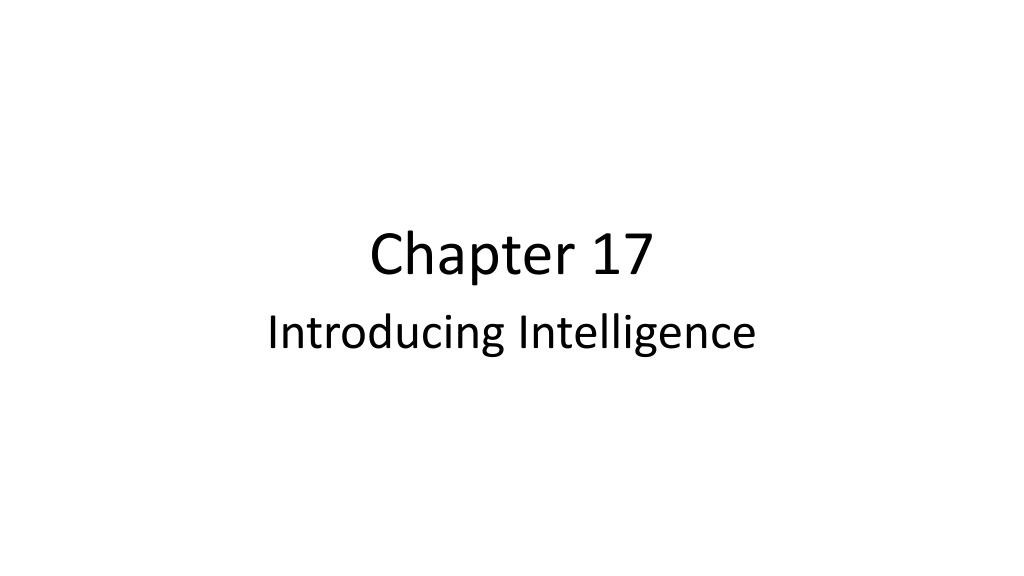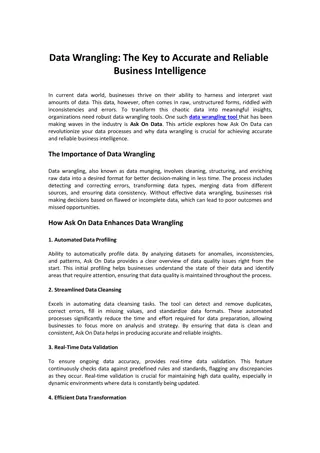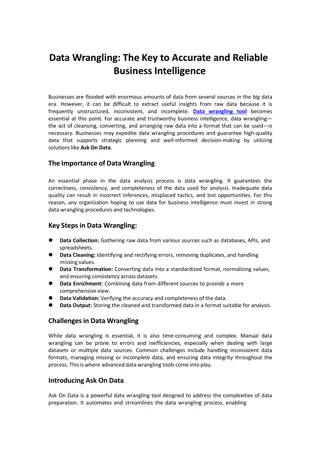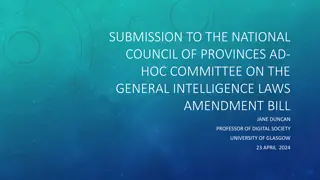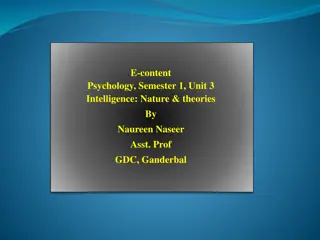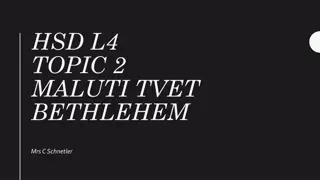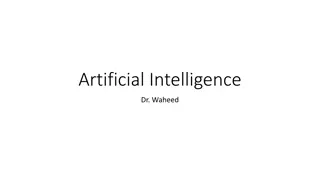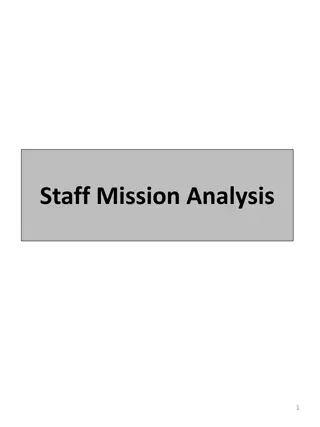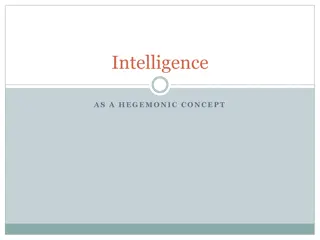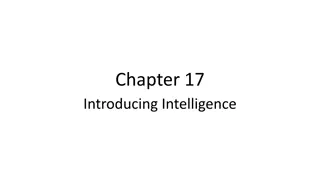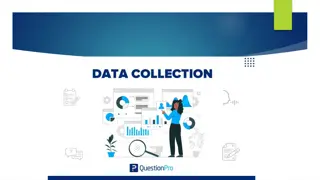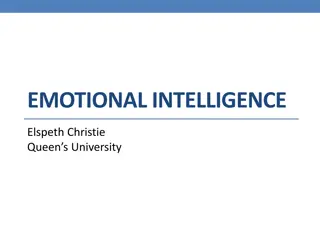Exploring Intelligence Services and Data Collection
The content delves into the fundamental divisions within intelligence services, legal issues related to information gathering, and the evolution of data collection methods pre and post packet-switched world. It highlights the challenges and implications of bulk data analysis, emphasizing the complexities and risks associated with modern intelligence operations.
Download Presentation

Please find below an Image/Link to download the presentation.
The content on the website is provided AS IS for your information and personal use only. It may not be sold, licensed, or shared on other websites without obtaining consent from the author. Download presentation by click this link. If you encounter any issues during the download, it is possible that the publisher has removed the file from their server.
E N D
Presentation Transcript
Chapter 17 Introducing Intelligence
Basic Divisions in the Intelligence Service Information and analysis The legal issues are generally 4thand 5thAmendment related informational privacy and entry into private property. Much of this is now controlled by statutes. Covert operations The legal issues can include criminal law and violations of international law. 2
Information and Analysis Key Take Away Except at the lowest level, information collection and analysis blend together, making it impossible to have objective intelligence. 3
The INTS 5
Data Collection before the Packet-Switched World These INTS pre-date the modern computer world. Geospatial data originally meant surveyors Open source - reading newspapers, etc. SIGINT flag codes on ships Data collection was almost always targeted. Most was collected by people Storage meant filing cabinets It was difficult to repurpose data because it was contained in paper documents. 6
Post-Packet-Switched World All of the INTS except HUMINT have been transformed by the electronic data world. Collection is now much easier and cheaper. Bulk collection of entire collections of raw information is now possible. One example is metadata from all US phone calls. Data becomes purpose independent all data can be stored and used for many purposes, now and in the future. 7
Raw Data - Call Detail Record Unlike targeted collection, such as a wiretap, this bulk data only becomes valuable when you analyze it to detect patterns of calls by a phone linked to the individuals you want to surveil. 8
The Implications of Cheap Bulk Data Analysis does not scale, meaning that the more data you collect, the more connections there are between data items and the more difficult the analysis. The cost of analysis goes up exponentially with the size of the database of potentially connected data. The chance of errors also goes up It is easy to find things, once you know what they are after an incident, so you are more subject to second-guessing. This was a major issue after 9/11 and lead to questionable reforms. 9
The Legal Issues with Bulk Data (We will look harder at these in later chapters.) Do you have an expectation of privacy in metadata? Does that answer change when the government can do pattern matching on all of the metadata? Is the government having access without a warrant to one cell phone location different from having access to all your cell phone locations through time? What about when the government uses your phone number as the seed to do targeted searches of the data? 10
Redundancy versus Silos Since intelligence collection and analysis requires human judgment, it has been traditionally seen as better to have multiple organizations running roughly parallel intelligence operations. It is assumed that they will approach the problems differently and what one misses, another may find. Post 9/11 the push has been to streamline intelligence and funnel it through one channel. This leads to tunnel vision the failure to see outside the current paradigm. 11
Covert Actions Covert action is a means to implement policy and is intended to influence people and events without revealing the source, or perhaps even the existence, of the influence. Since its coming of age as an instrument of U.S. policy after World War II, covert action has taken various forms, from barely more intrusive than diplomacy to large-scale military operations. What they all have in common is an intent that the hand of the United States be invisible that the operation be plausibly deniable. By contrast, clandestine military operations are initially secret for operational reasons, but are not intended to remain secret after the operations are concluded. 12
Covert Actions and the Law Foreign covert actions As we learned, unless constrained by statute, foreign actions against foreign nationals do not implicate US Constitutional rights. They can violate treaties and international law without legal consequences. Domestic covert actions There is little legal working room for domestic covert actions. (See discussion of the Church Committee in later chapters.) 13
Chapter 18 The Intelligence Community: Organization and Authority
Learning Objectives The history of intelligence agencies in the US The three inflection points in US intelligence: WWII, The Church Committee, and 9/11 The organization of the intelligence agencies The division between domestic and international intelligence collection The 9/11 changes that funnel intelligence through the Director of National Intelligence (DNI) This is not a substantive law chapter, in that the structural organization of intelligence is not justiciable. We will look at the specific law in later chapters. 15
Government Secrets Did the founders anticipate that there would be government secrets? What about the constitutional convention itself? May Congress keep its proceedings secret? Article I, Section 5: Each House may determine the Rules of its Proceedings . Each House shall keep a Journal of its Proceedings, and from time to time publish the same, excepting such Parts as may in their Judgment require Secrecy What was the practice for executive branch agencies until FOIA? Everything was withheld as a matter of practice, although only a small part was classified. It was available in litigation and agencies were permitted to release information. 16
Secret Agents The necessity of procuring good intelligence is apparent and need not be further urged. GEORGE WASHINGTON, 1777 Private agents were used as far back as Washington and were used by Lincoln during the Civil War. There is no formal regulation or statutory format for private agents. Remember the case where the private agent tried to get paid and could not because the work was secret? Rudy Giuliani was potentially working as a private agent for the President Trump. 18
Domestic Intelligence Services The Beginning of the FBI 1908 Teddy Roosevelt Originally the Bureau of Investigation Under the DOJ, displacing private agents, but not eliminating them J Edgar Hoover was appointed head in 1924 Became the FBI in 1935 Hoover remained the director until his death in 1972. Only domestic, although it can assist with foreign investigations. The FBI is a division of the DOJ and does not have a separate statutory framework. It does operate under EO 12,333 when doing intelligence work. 19
Foreign Intelligence Services Beginning in the 1880s, military and naval attach s at American embassies overseas were often spies in uniform, collecting information about the host country. In the 1920s, the State Department and the Army ran a successful Cipher Bureau, but Secretary of State Henry Stimson shut it down, famously declaring that it was wrong for gentlemen to read each other s mail. 20
Pearl Harbor In the months before Pearl Harbor, both the Navy and the Army were reading various Japanese coded messages. Their failure to work together was one of the reasons the Japanese achieved surprise and destroyed much of the Pacific fleet in December 1941, thereby thrusting the United States into World War II. Pearl Harbor became the iconic intelligence failure of the 20th century and one of the driving forces for more and better strategic intelligence. 21
The OSS Office of Strategic Services The wartime Office of Strategic Services (OSS) grew out of this failure, and the post-war CIA grew out of OSS. Allen Dulles, who served both as an OSS station chief and later as CIA Director in the 1950s, captured an important change in the atmosphere in Washington by declaring: When the fate of a nation and the lives of its soldiers are at stake, gentlemen do read each other s mail. 22
The CIA Central Intelligence Agency President Truman dissolved the OSS at the end of WWII. The growing threat of the Cold War with the Soviet Union lead to the passing of the National Security Act of 1947, which created the US Air Force, the Office of the Secretary of Defense, and the Central Intelligence Agency. 23
The CIA and the Implicit Authorization for Covert Actions The Central Intelligence Agency Act of 1949 waives the normal restrictions placed on government acquisition of materiel, hiring, and accounting for funds expended. If Congress did not believe that some type of clandestine activity had been authorized by the National Security Act, these provisions would not have been necessary. We will look at this in more detail in Chapter 19. The CIA has a long history of intelligence and covert action failures, including the fall of the Shaw of Iran, the fall of the Soviet Union, and 9/11. Legacy of Ashes 24
Operation CHAOS - Halkin v. Helms, 690 F.2d 977 (1982) Domestic Clandestine Operations Against US Citizens (Background for the Church Committee) 25
What was Operation CHAOS? (Get Smart, TV spy sitcom, starts Sept 1965. The villain was KAOS.) CHAOS was begun in 1967 by appellee Helms, who at the time was Director of Central Intelligence. Remember the CIA had no domestic authority An intelligence-gathering activity conducted by the CIA originally at the request of President Johnson It sought to determine the extent to which foreign governments or political organizations exerted influence on or provided support to domestic critics of the government s Vietnam policies. It was directed at the anti-war movement and the civil rights movement, as well as domestic communist organizations. 26
The Parties The plaintiffs Appellants are 21 individuals and 5 organizations who in the late 1960 s and early 1970 s were involved in various activities seeking to protest and secure an end to the involvement of the United States in the Vietnam War. A lot of this was happening on college campuses The defendants The individual appellees are seven named persons and an unspecified number of John Does who at the time plaintiffs claims arose were officials of the CIA or were otherwise agents or employees of the United States government. 27
How did CHAOS collect information? Operation CHAOS made use of the facilities of other ongoing CIA surveillance programs. These included: (1) the CIA letter-opening program, which was directed at letters passing between the United States and the Soviet Union, and involved the examination of correspondence to and from individuals or organizations placed on a watchlist ; (2) the Domestic Contact Service, a CIA office which solicits foreign intelligence information overtly from willing sources within the United States; (3) the CIA s Project 2, which was directed at the infiltration of foreign intelligence targets by agents posing as dissident sympathizers and which, like CHAOS, had placed agents within domestic radical organizations for the purposes of training and establishment of dissident credentials; (4) the CIA s Project MERRIMAC, operated by the Office of Security, which was designed to infiltrate domestic antiwar and radical organizations thought to pose a threat to the security of CIA property and personnel; and (5) Project RESISTANCE, also a creature of the Office of Security, which gathered information on domestic groups without any actual infiltration. 28
How were international electronic communications tracked? Between 1967 and 1973, the FBI, the Secret Service, and military intelligence agencies, as well as the CIA, submitted the names of domestic individuals and organizations on watchlists to NSA, and ultimately acquired through NSA the international communications of over a thousand American citizens. 29
The Discovery Fight over Classified Information The district court was on solid ground in refusing to compel production of documents on the basis of the Director s claim as asserted in the public affidavit without resort to any more detailed justification. . . . [The court also refused to compel the defendants to answer interrogatories or appear for oral depositions.] Since the plaintiffs needed the classified information to go forward, the case was dismissed. 30
The Church Committee and Operation COINTELPRO 31
Who did COINTELPRO operations target? FBI driven The Ku Klux Klan, Black Nationalists (civil rights organizations), and the New Left (anti-war activists) 32
What sort of covert actions were carried out? Covert techniques used in this COINTELPRO included creating new Klan chapters to be controlled by Bureau informants and sending an anonymous letter designed to break up a marriage. The larger objectives were to counter their propensity for violence and to frustrate their efforts to consolidate their forces or to recruit new or youthful adherents. Field offices were instructed to exploit conflicts within and between groups; to use news media contacts to ridicule and otherwise discredit groups; to prevent rabble rousers from spreading their philosophy publicly; and to gather information on the unsavory backgrounds of group leaders. 33
What were the long-term goals of the operation against Black Nationalists? (1) prevent the coalition of militant black nationalist groups ; (2) prevent the rise of a messiah who could unify and electrify the movement, naming specifically Dr. Martin Luther King, Jr., Stokely Carmichael, and Elijah Muhammed; (3) prevent violence by pinpointing potential troublemakers and neutralizing them before they exercise their potential for violence ; (4) prevent groups and leaders from gaining respectability by discrediting them to the responsible Negro community, the responsible white community, liberals with vestiges of sympathy for militant black nationalist and Negro radicals ; and (5) prevent these groups from recruiting young people. 34
Why was the FBI worried about the New Left? The nation was undergoing an era of disruption and violence which was caused to a large extent by individuals generally connected with the New Left. Some of these activists were urging revolution and calling for thedefeat of the United States in Vietnam. 35
How did these groups try to hamper FBI investigations? The problem was not just that they committed unlawful acts, but also that they falsely alleged police brutality, and that they scurrilously attacked the Director and the Bureau in an attempt to hamper FBI investigations and to drive us off the college campuses. 36
What actions were recommended against the New Left? (1) prepare leaflets using themost obnoxious pictures of New Left leaders at various universities; (2) instigate personal conflicts or animosities between New Left leaders; (3) create the impression that leaders are informants for the Bureau or other law enforcement agencies (the snitch jacket technique); (4) send articles from student or underground newspapers which show depravity ( use of narcotics and free sex ) of New Left leaders to university officials, donors, legislators, and parents; (5) have members arrested on marijuana charges; (6) send anonymous letters about a student s activities to parents, neighbors and the parents employers; (7) send anonymous letters about New Left faculty members (signed A Concerned Alumni or A Concerned Taxpayer ) to university officials, legislators, Board of Regents, and the press; (8) use cooperative press contacts ; (9) exploit the hostility between New Left and Old Left groups; (10) disrupt New Left coffee houses near military bases which are attempting to influence members of the Armed forces ; (11) use cartoons, photographs, and anonymous letters to ridicule the New Left; (12) use misinformation to confuse and disrupt New Left activities, such as by notifying members that events have been cancelled. 37
Church Committee Finding Intelligence agencies have undermined the constitutional rights of citizens, the final report concluded, primarily because checks and balances designed by the framers of the Constitution to assure accountability have not been applied. In a separate appended view, Senator Tower acknowledged intelligence excesses and the need for expanded legislative, executive, and judicial involvement in intelligence policy and practices. He cautioned, however, that Congress should not unnecessarily restrain the president from exercising discretion in the realm of national security. 38
Church Committee Recommendations The final report included 96 recommendations, legislative and regulatory, designed to place intelligence activities within the constitutional scheme for controlling government power. The committee observed that there is no inherent constitutional authority for the President or any intelligence agency to violate the law, and recommended strengthening oversight of intelligence activities. The Church Committee s thoughtful and careful investigative work, which earned it the respect of many members of the Senate, ultimately led to reform efforts throughout the intelligence community. 39
Statutory Reforms Congress approved legislation to provide for greater checks and balances of the intelligence community. In 1976 the Senate approved Senate Resolution 400, establishing the Senate Select Committee on Intelligence, to provide vigilant legislative oversight over the intelligence activities of the United States to assure that such activities are in conformity with the Constitution and laws of the United States. In 1978 Congress approved and President Jimmy Carter signed into law the Foreign Intelligence Surveillance Act (FISA), requiring the executive branch to request warrants for wiretapping and surveillance purposes from a newly formed FISA Court. 40
Executive Branch Reforms Some agencies pursued internal reform, in part because the Church Committee s inquiry revealed the extent to which agencies had encouraged, or permitted abuses, by individuals. One example includes new guidelines established by Attorney General Edward Levi. The executive branch issued Executive Order 12036 in 1978, which provided new guidelines related to intelligence activities (revoked in 1981). Some of these are embodied in EO 12,333. 41
The Long-Term Impact of the Church Committee FISA was the only proposed major statutory reform that passed. The death of Hoover was probably more important to the reform of the FBI. While the Internet revolutionized private communication, government communications were mostly electronic by the 1970s, increasing the power of the NSA. Politics favored electronic data surveillance over shoe-leather intelligence. More money to be made by defense contractors. Easier to administer Fewer moral dilemmas. These shifts buried the concerns raised by the Church Committee. The shift to SIGNIT left the US vulnerable to NGO attacks by tribal actors who did not depend on electronic communications. 42
Hobson v. Wilson, 737 F.2d 1, 10 (D.C. Cir. 1984) Hobson v. Wilson, 737 F.2d 1, 10 (D.C. Cir. 1984) Plaintiffs in DC sued over Operation Chaos The plaintiffs prevailed against the FBI. The Court of Appeals stated, Government action taken with the intent to disrupt or destroy lawful organizations, or to deter membership in those groups, is absolutely unconstitutional. Why was the result different from Halkin v. Helms? They could get the documents necessary for prosecuting the claims because there was no justification for classification. 43
The Post 9/11 Legal Framework for Intelligence Agencies 44
The Wall between Domestic and Foreign Intelligence Until 911, both the left and the right demanded that domestic and foreign intelligence be kept separate. The rules were fundamentally different for foreign intelligence and it was assumed that it would be difficult to protect the rights of US citizens in the US if foreign intelligence services were allowed to operate in the US. There was also a separation between state and local law enforcement and federal law enforcement. This was again based on keeping role separate to protect individual rights and because each side distrusted the other. 45
9/11 Commission Recommendations There was a bipartisan push to create a national surveillance state because of the 9/11 fears. Few appreciated how the growing Internet world would empower this this surveillance state. The Recommendations unify strategic intelligence and operational planning against Islamist terrorists across the foreign-domestic divide with a National Counterterrorism Center; unify the intelligence community with a National Intelligence Director; unify the many participants in the counterterrorism effort and their knowledge in a network-based information-sharing system that transcends traditional governmental boundaries; unify and strengthen congressional oversight to improve quality and accountability; and strengthen the FBI and homeland defenders. 46
The DNI becomes the gatekeeper and organizer of The DNI becomes the gatekeeper and organizer of intelligence. intelligence. 3024. Responsibilities and authorities of the Director of 3024. Responsibilities and authorities of the Director of National Intelligence National Intelligence 47
(a) Provision of intelligence (1) The Director of National Intelligence shall be responsible for ensuring that national intelligence is provided (A) to the President; (B) to the heads of departments and agencies of the executive branch; (C) to the Chairman of the Joint Chiefs of Staff and senior military commanders; (D) to the Senate and House of Representatives and the committees thereof; and (E) to such other persons as the Director of National Intelligence determines to be appropriate. (2) Such national intelligence should be timely, objective, independent of political considerations, and based upon all sources available to the intelligence community and other appropriate entities. 48
(b) Access to intelligence Unless otherwise directed by the President, the Director of National Intelligence shall have access to all national intelligence and intelligence related to the national security which is collected by any Federal department, agency, or other entity, except as otherwise provided by law or, as appropriate, under guidelines agreed upon by the Attorney General and the Director of National Intelligence. 49
(f) Tasking and other authorities (1)(A) The Director of National Intelligence shall (i) establish objectives, priorities, and guidance for the intelligence community to ensure timely and effective collection, processing, analysis, and dissemination (including access by users to collected data consistent with applicable law and, as appropriate, the guidelines referred to in subsection (b) of this section and analytic products generated by or within the intelligence community) of national intelligence; 50
